Biomes Guide
In the game Deep Rock Galactic, Hoxxes IV is a planet that holds incredibly high amounts of resources yet an extremely hazardous environment. Aside from the threats generated by natural phenomena, players also have to contend with the ever-present dangers of the local fauna, in the form of hostile bugs that come in different shapes and sizes. In this page, we will quickly cover the various biomes found in the planet where missions take place and what resources they have to offer.
About Biomes
Missions take place on different biomes. These missions are also rotated regularly, along with random factors like Warnings and Anomalies. Furthermore, specific materials can only be acquired on specific biomes. Even if the cave systems players will explore are procedurally-generated, the diverse local flora and the general properties of each biome remain the same.
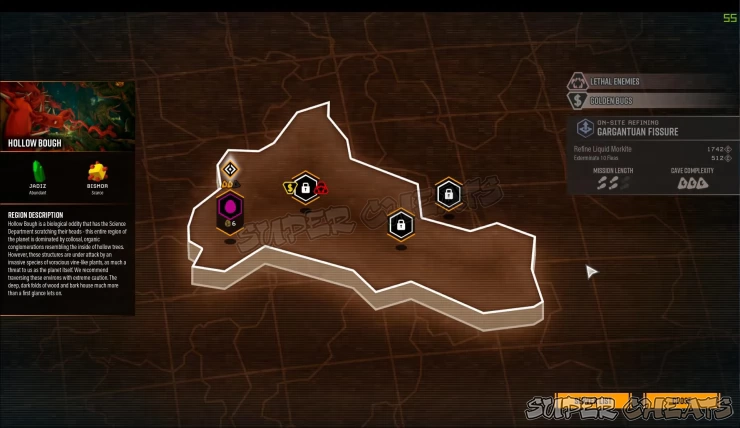
Crystalline Caverns
Among the most spectacular sights on Hoxxes, the aptly-named Crystalline Caverns are truly a sight to behold. Massive crystals erupt from every surface, glittering and twinkling in the dark. Alas, the larger crystals are mostly worthless silicate, but abundant deposits of valuable minerals dot the caves too.
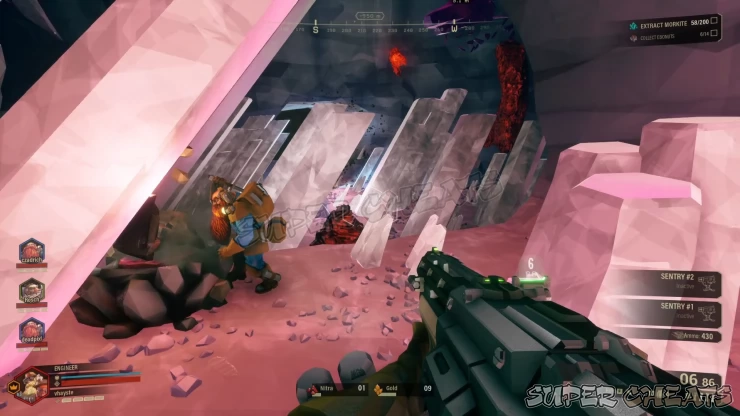
| Abundant Materials | Scarce Materials |
|---|---|
| Jadiz | Bismor |
Biome Properties
* This biome almost has no flora since it’s mostly made out of solid rock layers.
* Luminescent blue crystals emit some light which can aid navigation.
* Electrocrystals can shock and slow down dwarves or bugs alike. The electric current can jump between crystals.
* Webs can temporarily slow down dwarves or briefly hamper players’ screens. These can be burned or ignored.
Salt Pits
The Salt Pits of Hoxxes was once the location of a huge underground lake. It dried up billions of years ago and left huge crystallized deposits of red salt. Red salt - though worthless - tastes really good on Glyphid omelettes.
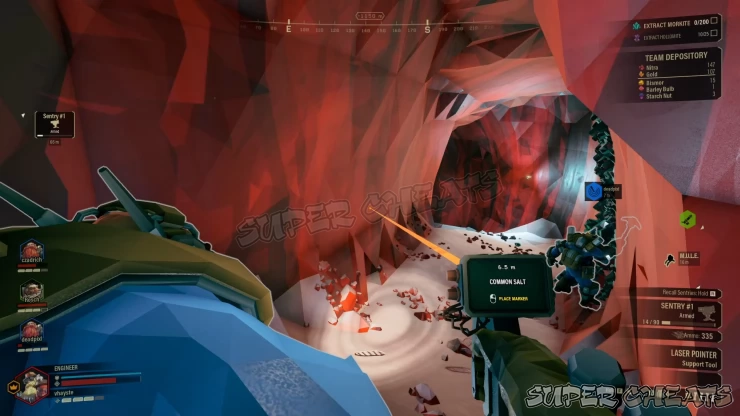
| Abundant Materials | Scarce Materials |
|---|---|
| Enor Pearl | Bismor |
Biome Properties
* This biome almost has no flora due to the abundance of salt in the caverns.
* Luminescent red crystals emit some light which can aid navigation.
* There are unstable crystal chunks on the ceiling that can fall on an enemy or player, dealing huge damage. Thankfully, these accidents will not happen naturally as the crystals need to be hit by weapons to be dislodged.
* There are also fragile platforms that can only hold a dwarf’s weight for a few seconds before crumbling away.
Fungus Bogs
We're almost sorry to send employees in here, but the rewards are too great to ignore. So therefore: Welcome to the Fungus Bogs! A truly awful region, built mostly from slime, mold, stinging insects, fungus, stinking mud, and corrosive lichen.
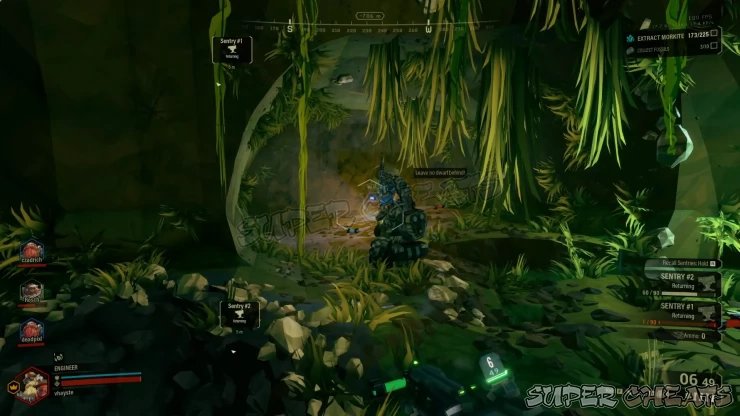
| Abundant Materials | Scarce Materials |
|---|---|
| Croppa | Jadiz |
Biome Properties
* There are fungi with poisonous spores that damage dwarves if they get too close.
* A sticky goo on the terrain can greatly slow down any dwarf or bug that crosses it.
* There are volatile, explosive fungi that will detonate when sufficiently damaged. The blast is powerful enough to trigger nearby, similar explosive fungi, triggering a deadly chain explosion.
* There are stalks with bioluminescent purple bulbs. Hit all five bulbs for the plant to light up permanently.
* Geysers produce a violent stream of hot gas and steam, powerful enough to propel dwarves in the opposite direction. These geysers can be destroyed which will cause a powerful explosion that can deal great damage to surrounding dwarves or glyphids.
* Glyphid eggs can spawn Glyphid Swarmers when damaged.
Radioactive Exclusion Zone
Ravaged by thousands of years of high-intensity gamma radiation, this region of the planet is now a veritable hellhole of radioactive ash and decrepit, mutated flora. Move with great care, and pay particular attention that you maintain full detox procedure upon return.
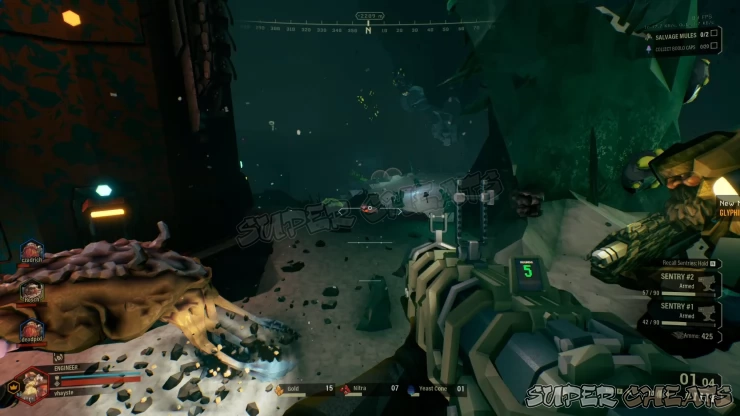
| Abundant Materials | Scarce Materials |
|---|---|
| Umanite | Enor Pearl |
Biome Properties
* Volatile Uranium are green-colored crystals that can cause radiation damage to any dwarf or glyphid that gets near it. You can destroy these crystals by shooting them.
* Webs can temporarily slow down dwarves or briefly hamper players’ screens. These can be burned or ignored.
* The glyphids you might encounter in this biome may be irradiated and resistance to radiation damage.
Dense Biozone
Whoever said plant life needs access to sunlight has obviously never visited Hoxxes. This region is dominated by what can best be described as a subterranean rainforest - masses of writhing, (mostly carnivorous) plant life, producing entire microcosms of life deep within the crust of the planet. Tread with care.
| Abundant Materials | Scarce Materials |
|---|---|
| Bismor | Umanite |
Biome Properties
* There are “elevator” plants that can lift or lower dwarves when they step on it or when the luminescent part of the plant is damaged.
* Small plants with glowing bulbs will open up when approached, illuminating a small area.
* There are volatile plants that will detonate if damaged, similar to the ones found in Fungus Bogs and Magma Core.
* There are spiky plants that shoot out spikes in several directions, capable of damaging dwarves, enemies, and even detonate the volatile explosive plants described above.
* Glyphid eggs can spawn Glyphid Swarmers when damaged.
* Webs can temporarily slow down dwarves or briefly hamper players’ screens. These can be burned or ignored.
* Spiky cacti-like plants that can damage dwarves who get in contact with it.
* Cacti-like, egg-shaped, purple plant that has several holes in it. When damaged or approached, the plant will shoot out damaging spikes through the holes.
Glacial Strata
At least one of our xenogeologists quit in a rage when research started on this region. Instead of having conventional polar ice caps, and in violation of all physical laws we know of, the continental plates of Hoxxes rest on top of a planetwide permafrost layer several miles deep. As always, DRG recommends a "don't ask" approach when dealing with the peculiarities of Hoxxes' makeup.
| Abundant Materials | Scarce Materials |
|---|---|
| Magnite | Umanite |
Biome Properties
* A blizzard can take place in this biome, slowing down dwarves and enemies alike and drastically reducing vision. Players will know if a blizzard is about to start when there’s a change in visibility.
* Due to the environment they’re in, glyphids will also have special properties that match up with the biome’s ice theme. For example, the Glyphid Frost Praetorian will spew out freezing liquid instead of acid.
* There are spots of warm oasis, which can be easily identified with red vegetation and steam. Standing near one will quickly raise a dwarf’s temperature.
* There are plants that contain liquid inside. When damaged enough, it will burst, releasing the liquid inside and freezing instantly - creating a stable platform to stand on.
* There are cracks and crevices that release cold air regularly. They won’t deal any damage but any dwarf hit by the cold air will get his temperature lowered rather quickly.
* Unstable Ice stalactites hanging on the ceiling can fall down when damaged or disturbed by an explosion.
* Smooth ice patches will cause dwarves to slip and slide.
* Thick snow piles will greatly hamper a dwarf’s movement. Falling on these thick snow piles will greatly reduce fall damage as well.
* There are unstable sheets of ice on the floor that will break when stepped on, trapping dwarves inside. There are rock formations that players can use to escape the pit.
Hollow Bough
low Bough is a biological oddity that has the Science Department scratching their heads - this entire region of the planet is dominated by collosal, organic conglomerations resembling the inside of hollow trees. However, these structures are under attack by an invasive species of voracious vine-like plants, as much a threat to us as the planet itself. We recommend traversing these environs with extreme caution. The deep, dark folds of wood and bark house much more than a first glance lets on.
| Abundant Materials | Scarce Materials |
|---|---|
| Jadiz | Bismor |
Biome Properties
* This biome is filled with large, thorny vines that also serve as a consistent hazard while exploring.
* Thinner variants of the thorny vines can be damaged and cause it to retract back.
Azure Weald
The Azure Weald is a chilly place, every bit as hostile as the rest of Hoxxes IV - but still, we cannot deny it is oddly beautiful. Dazzling, bioluminescent clusters of lichen light up the darkness, illuminating this fertile and overgrown Region in flickering neon colors. Don't let that lull you into a false sense of security however - the Azure Weald brings to mind the deep jungle, in all its splendor and horror - and much like its terrestrial counterparts, it is absolutely not out to make friends. Kill or be killed - that is the law in this place.
| Abundant Materials | Scarce Materials |
|---|---|
| Croppa | Umanite |
Biome Properties
* Illuminated pillars in a circle formation that provides damage reduction effects to dwarves and other creatures inside the protective circle. The effect lasts for a few seconds after leaving the formation.
* There’s a large, lit hole where players can experience low gravity and gain 30% movement speed for a few seconds.
Magma Core
Among the deepest of our mining sites, the Magma Caves are a mellow 250-400 degrees and helpfully lit by the churning, molten innards of the planet. We advise that you do not touch anything not mandated by the mission objectives, as your employee insurance does not cover burns.
| Abundant Materials | Scarce Materials |
|---|---|
| Magnite | Croppa |
Biome Properties
* This hellish biome can produce quakes which slows down dwarves and glyphids alike.
* There are volatile plants that will detonate if damaged. The larger the size of the plant’s bulb, the more volatile it is, capable of exploding with the smallest damage inflicted on it.
* Lava Geysers can be found in this biome that regularly shoots molten rock upward, burning any dwarf or creature near it. It can be destroyed, but doing so will result in a violent blast, dealing heavy damage to any creature near it.
* Lava patches are scattered in large, open floors. Stepping on it will cause damage to any dwarf or glyphid.
* Small lava geysers will continuously spray out fiery, molten rock that will deal damage to anyone in contact with the fire.
Sandblasted Corridors
This region is dominated by windblasted and arid tunnels reaching dozens of miles below ground. The particular composition of the surrounding rock means practically no moisture, resulting in one of the driest regions of the planet. With water being so precious, the inhabiting wildlife is particularly aggressive, ravenous for whatever fluids reside within their prey.
| Abundant Materials | Scarce Materials |
|---|---|
| Enor Pearl | Magnite |
Biome Properties
* Sandstorms occur exclusively in this biome. During a sandstorm, both dwarves and creatures will be slowed down while also reducing a dwarf’s visual range.
* The Deeptora Honeycomb is exclusively found in this biome, an organic structure that contains hostile and angry bee swarms. When approached, the swarm will attack the player. To kill the bee swarm, you’ll need any weapon or explosive that sets enemies on fire (such as the Flamethrower).
* The Nayaka Trawler is a hostile, burrowing creature exclusively found in this biome. It’s very mobile and will cruise underground. It will attempt to grab a dwarf and drag it away, with the capacity to easily incapacitate any dwarf. This makes it a quite deadly threat which should be terminated with extreme prejudice.
* A variant of an explosive plant will pop out a volatile bulb when damaged. The bulb detonates upon impact and will regenerate after a few seconds.
* There are wind tunnels that produce really powerful gusts of wind that can throw dwarves quite a distance away, which can be fatal.
Anything missing from this guide?
ASK A QUESTION for Deep Rock Galactic
 Join us on Discord
Join us on Discord
